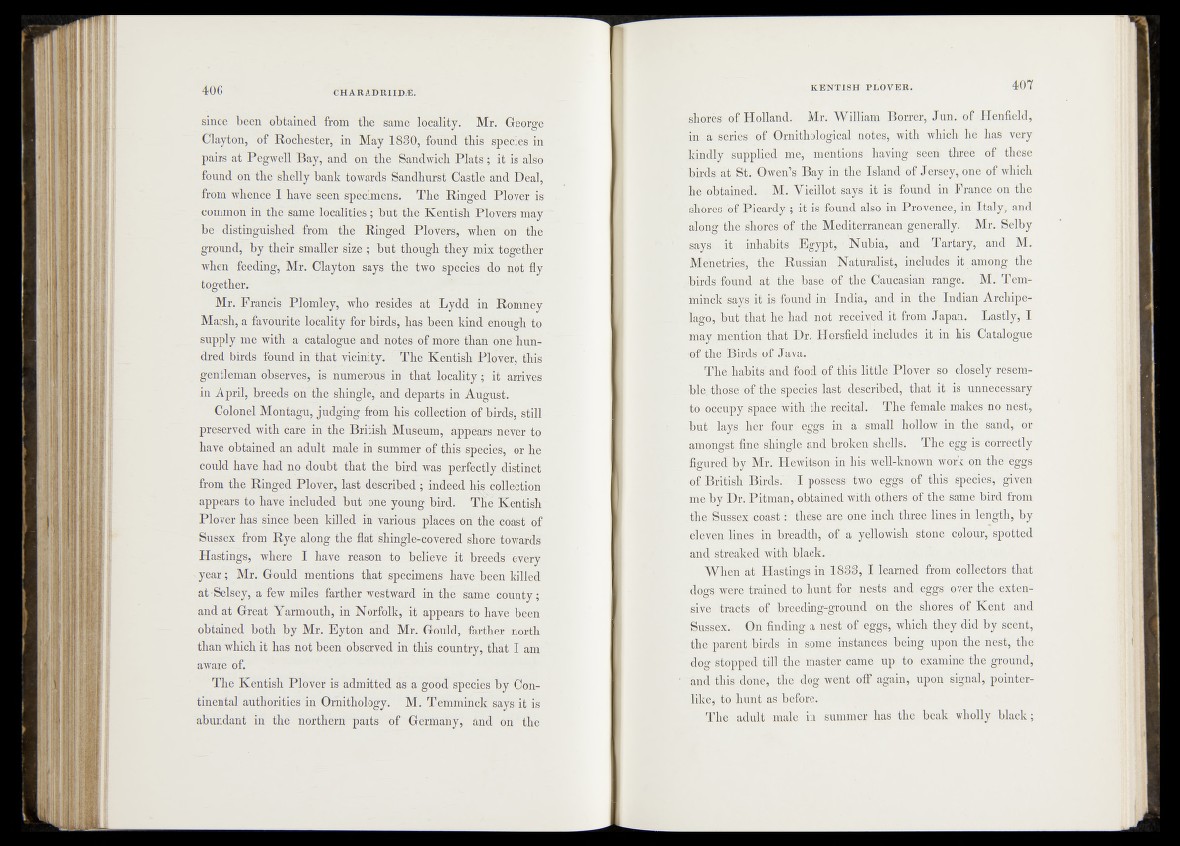
since been obtained from the same ' locality. Mr. George
Clayton, of Rochester, in May 1830,-found this spécies in
pairs at Pegwell Bay, and on the Sandwich Plats; it is also
found on the shelly bank towards Sandhurst Castle and Deal,
from whence I haye seen specimens. The Ringed Plover is
common in the same localities'; but the Kentish Plovers may
be distinguished- from the Ringed Plovers, when on the
ground, by their smaller size ; but though they mix together
when feeding, Mr. Clayton says the^two species do not fly
together;
Mr, Francis Plomley,-who resides at Lydd in Romrféj'
Marsh, a favourite locality for birds, has been kind enough, to
supply me with a catalogue' àtîd „notés of more than oml'hundred
birds found in that vicinity.’ ‘ The Kentish Plover, this
gentleman observes, is. numerouiTnn tha't^eMity '; if aWSpSl
in April, breeds on the shingle, and departs in Adgust.
Colonel Montagu, judging-from h^tcollection of birds,' still-
preserved with c atejh "the British Museum, appears ne^trft©
have obtained an adult male in summer of this species, or he
could have, had no -doubt that the bird was perfectly^dlstmet
from the Ringed Plovér, last described ; indeed his. collection
appears to have included but one young bird. The KëntiSh
Plover has since’ been killed in various places on the ^ a s f ^ f
Sussex from Rye along the flat shhigle-coVéred shore towards
Hastings, where I have reason toljfÉéve it breeds" every
year; Mr. Gould mentions that specimens have been killed
at-Selsey, a few miles farther westward in the same county ;
and at Great Yarmouth, in Norfolk, it appears to have been
obtained both by Mr. Eyton and Mr. Gould, farther north
than which it has not been observed in this country, that I am
aware of.
The Kentish Plover is admitted as a good species by Continental
authorities in Ornithology. M. Temminck s'ays it. is
abundant in the northern parts of Germany, and on the
shores of Holland. Mr. William Borrer, Jun. of Henfield,
in a series of Ornithological notes, with which he has very
„kindly , supplied niep, mentions having seen three of these
-birds at St. Owen’s Bay in the Island of Jersey, one of which
he. obtained.* ,M. Yieillot says it is found in France on the
-shores,of Picardy.; it is found also in Provence, in Italy, and
along;the Shores .of the Mediterranean generally. Mr. Selby
^ysif, it inhabits. Egypt, ■ Nubia, and' Tartary, and M.
Menetries, the Russian Naturalist, includes it among the
Jirfls found at the fbhsek’of the Caucasian range. . M. Tem-
mincl^ays; it is found in- India, and in the Indian Archipelago,
M-tcthat«! :had not received it from Japan. Lastly:, I
may mention that Dr. Horsfield includes it--in his,'Catalogue
-of „the Birdsfof Java.i.
The JiaBitsl and fdodfof ;this':lit’tle. Plover so closely resem-
-bl^hoWcof the^spdeie’s last described, that if/-is unnecessary
|feojpccupy space with the.recital. The female makes no nest,
•buhvM^^er ffou-4 eggs- in a small hollqw in the sand, or
amongst fii^shingle and broken shells. TJie egg is correctly
figured by Mr. Hewitson in his? well-knpwn work on the eggs
of British Birds." I possess’ two eggs of this species, given
meby Dr- Pitman,. obtain ed with others of the same bird from
l-||e^üssei fclast*: these are ohe inch three lines in length, by
eleVeb^änjesMin breadth,.^ofi a, yellowish .stone colour, spotted
andv streaked rwith ;black. -
When at Hastings in 1838, I learned from collectors that
dogs were trained to hunti;föin nests and'eggs over the extensive
tracts of breeding-ground on the shores of Kent and
‘Sussex.. On finding a nes.^of eggs, which they did by scent,
the- parent birds in some instances being upon the nest, the
dog stopped till the master came up to examine the ground,
~and this done, the dog went off again, upon signal, pointerlike*
to1 hunt as before.
The adult male in summer .has the beak wholly black;